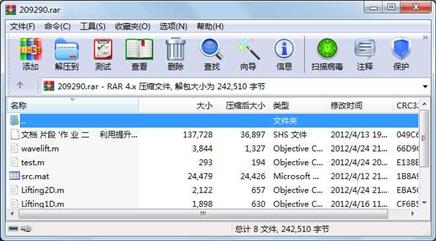资源简介
提升框架实现一维和二维信号的小波变换,采用的小波基是haar、db4和cdf

代码片段和文件信息
function [y opty] = colwavelift(x optx L direction mode)
%---------------------- input arguments checking ----------------------%
error(nargchk(4 5 nargin));
if nargin == 4
mode = direction;
direction = L;
L = optx;
end
% check optx
if nargin == 5
if size(optx 2) ~= size(x 2)
error(‘COLWAVELIFT:InArgErr‘ [‘The first two arguments must‘ ...
‘ have the same column numbers.‘]);
end
if ~isreal(optx) || ~isnumeric(optx) || (ndims(optx) > 2)
error(‘COLWAVELIFT:InArgErr‘ [‘The second arguments must‘ ...
‘ be a real numeric 2-D or 1-D matrix.‘]);
end
end
% check x
if ~isreal(x) || ~isnumeric(x) || (ndims(x) > 2)
error(‘COLWAVELIFT:InArgErr‘ [‘The first argument must‘ ...
‘ be a real numeric 2-D or 1-D matrix.‘]);
end
% check direction
if ischar(direction) && ismember(direction {‘d‘ ‘dec‘ ‘f‘ ‘forward‘})
direction = ‘d‘;
elseif ischar(direction) && ismember(direction {‘r‘ ‘rec‘ ...
‘b‘ ‘backward‘ ‘i‘ ‘inverse‘})
direction = ‘r‘;
else
error(‘COLWAVELIFT:InArgErr‘ [‘For the last argument use ‘‘d‘‘ ‘ ...
‘to denote decomposition/forward lifting \n or ‘‘r‘‘ for ‘ ...
‘reconstruction/inverse lifting.‘]);
end
% check mode
if ~ischar(mode) || ~ismember(mode {‘lossy‘ ‘lossless‘})
error(‘COLWAVELIFT:InArgErr‘ [‘The last argument must be either‘ ...
‘ ‘‘lossy‘‘ or ‘‘lossless‘‘ to decide the reversibility.‘]);
end
% check L
% a thorough check on L is too lengthy. see the comment lines
% for the way L is organized
if ~isstruct(L)
error(‘COLWAVELIFT:InArgErr‘ [‘Use a Matlab data type‘ ...
‘ ‘‘structure‘‘ to denote the lifting structure. \n Type‘ ...
‘ ‘‘help colwavelift‘‘ to see the way the structure shall be‘ ...
‘ organized.‘]);
end
%----------------------- input pretreatment ---------------------------%
% use notation y y0 y1 and clear x optx
if nargin == 4 % without optx
y0 = x(1:2:end :);
y1 = x(2:2:end :);
y = x;
else % nargin == 5 ie with optx
y0 = x;
y1 = optx;
y = zeros(size([y0; y1]));
y(1:2:end :) = y0;
y(2:2:end :) = y1;
end
clear x optx;
sy = size(y);
% for unit-length seqence skip lifting precess ie return y = x
if size(y 1) > 1
ry0 = size(y0 1); % y y0 y1 are changing during extension and
ry1 = size(y1 1); % lifting and inverse lifting processes while
% sy ry0 ry1 remain unchanged for use
len = length(L.lamdaz);
% default plus/minus switch for core lifting process
eval(‘plusminus = 1;‘);
%--------------------- symmetric extension -----------------------%
% Difficulty lies in the boundary handling. For the sake of the
% adaptability of lifting structure L more general but more complex
% treatment is employed here. Note for a single realization of FWT eg.
% for cdf9/7 or spline5/3 simpler algorithm can be used属性 大小 日期 时间 名称
----------- --------- ---------- ----- ----
文件 1898 2012-04-16 11:57 Lifting1D.m
文件 2122 2012-04-24 21:50 Lifting2D.m
文件 24479 2012-04-12 21:39 src.mat
文件 293 2012-04-24 20:59 test.m
文件 3844 2012-04-24 21:51 wavelift.m
文件 137728 2012-04-13 19:08 文档 片段 ‘作 业 二 利用提升框架实...‘.shs
文件 65240 2000-12-04 12:57 cameraman.tif
文件 6906 2012-04-24 20:17 colwavelift.m
----------- --------- ---------- ----- ----
242510 8
- 上一篇:序列密码发展报告
- 下一篇:bat自动监测并启动程序
 川公网安备 51152502000135号
川公网安备 51152502000135号
评论
共有 条评论